- Details
- Written by: Elmazen
- Category: Flags of Countries of the World
- Hits: 690
Flag of Venezuela
Flag of Venezuela, Currency, Population, Tourist Places, Culture, Borders
Exploring Venezuela: A Land of Beauty and Culture
Venezuela, a country in South America, is a land of vibrant culture, breathtaking landscapes, and rich history.
Here’s a detailed look at its demographics, national symbols, geography, and cultural highlights.
Flag of Venezuela
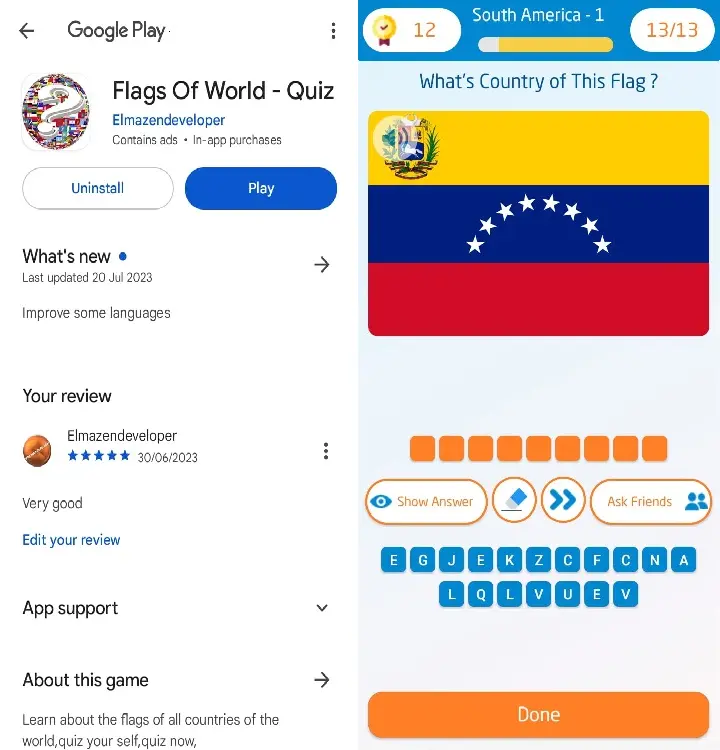
Download the application  Flags Of World - Quiz ,
Flags Of World - Quiz ,
And test your knowledge with Flags of World ,
1. Population of Venezuela
As of November 2024, Venezuela has an estimated population of 28.4 million people.
The population is concentrated in urban areas, with cities like Caracas, Maracaibo, and Valencia serving as hubs for economic and cultural activity.
2. Meaning of Venezuela’s Flag
The Venezuelan flag features three horizontal stripes of yellow, blue, and red, with eight white stars in a semicircle on the blue stripe.
Here's what it symbolizes:
- Yellow: Represents the wealth of the land, including gold, sunshine, and agricultural abundance.
- Blue: Signifies the sea separating Venezuela from Spain, symbolizing independence.
- Red: Represents the blood shed by those who fought for freedom.
- Eight Stars: Stand for the eight provinces that declared independence in 1811.
3. Venezuela’s Currency
The official currency of Venezuela is the Bolívar Soberano (VES).
Due to economic challenges and inflation, many Venezuelans also use the US dollar in daily transactions, particularly in urban areas.
Flag of Venezuela

Download the application  Flags Of World - Quiz ,
Flags Of World - Quiz ,
And test your knowledge with Flags of World ,
4. Venezuela’s Borders
Venezuela shares its borders with the following countries:
To the north, Venezuela is bordered by the Caribbean Sea, offering a coastline of stunning beaches and islands.
5. Culture of Venezuela
Venezuela’s culture is a vibrant mix of Indigenous, African, and Spanish influences.
Key elements include:
- Music: Styles like joropo, salsa, and merengue dominate, with traditional instruments like the cuatro (a small guitar).
- Food: Venezuelan cuisine features arepas (cornmeal patties), pabellón criollo (rice, beans, and shredded beef), and hallacas (Christmas tamales).
- Festivals: Major celebrations include Carnival, Semana Santa (Holy Week), and the Feria de la Chinita in Maracaibo.
- Sports: Baseball is the most popular sport, with many Venezuelans excelling in Major League Baseball.
6. Best Places to Visit in Venezuela
Venezuela is home to diverse landscapes, from Andean mountains to Caribbean beaches.
Must-visit destinations include:
- Angel Falls: The world’s tallest waterfall, located in Canaima National Park.
- Los Roques Archipelago: A paradise of crystal-clear waters, coral reefs, and white sandy beaches.
- Mérida: A city in the Andes known for its cable car system and outdoor adventures.
- Mochima National Park: A coastal park with stunning beaches and marine biodiversity.
- Roraima Mountain: A mystical flat-topped mountain offering challenging hikes and unique ecosystems.
- Caracas: The bustling capital city, rich in museums, parks, and history.
Conclusion
Venezuela is a country of contrasts, blending natural wonders with cultural depth.
Whether you’re drawn to its colorful traditions, breathtaking landscapes, or the warmth of its people, Venezuela offers something unforgettable for every visitor.
Flag of Venezuela

Download the application  Flags Of World - Quiz ,
Flags Of World - Quiz ,
And test your knowledge with Flags of World ,
- Details
- Written by: Elmazen
- Category: Flags of Countries of the World
- Hits: 650
Flag of Uruguay
Flag of Uruguay, Currency, Population, Tourist Places, Borders, Culture
Exploring Uruguay: A South American Gem
Uruguay, a small yet vibrant country nestled in South America, offers a unique blend of culture, history, and breathtaking landscapes.
Let’s dive into some fascinating aspects of this charming nation.
Flag of Uruguay
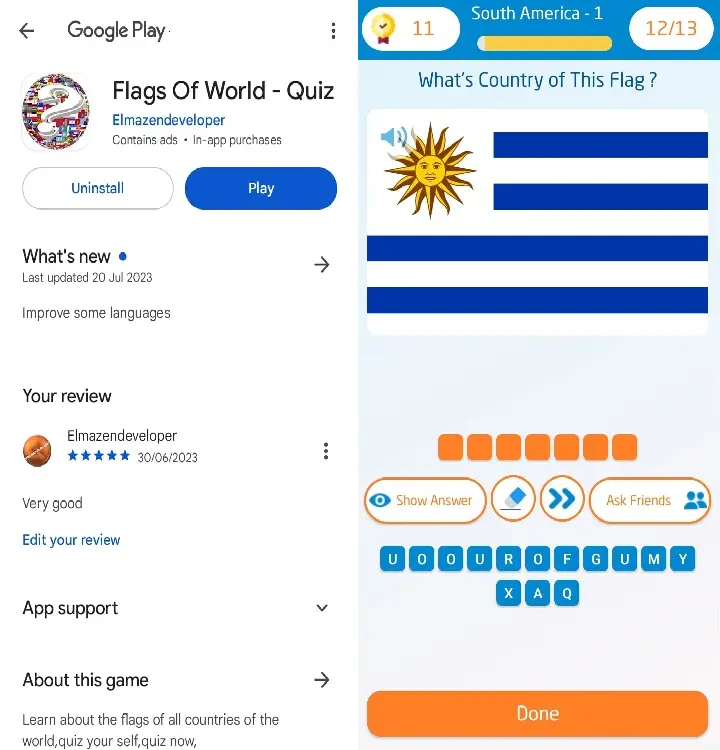
Download the application  Flags Of World - Quiz ,
Flags Of World - Quiz ,
And test your knowledge with Flags of World ,
1. Population of Uruguay
As of November 2024, Uruguay has a population of approximately 3.385 million people.
The majority of the population lives in urban areas, with nearly half residing in the capital city, Montevideo.
The country enjoys a high standard of living and boasts a literacy rate of over 98%.
2. Uruguay's Flag Meaning
Uruguay’s flag, known as the "Pabellón Nacional", features:
- Nine horizontal stripes alternating white and blue, symbolizing the nine original departments of Uruguay when it declared independence.
- The Sun of May in the upper left corner, a radiant golden sun with a face, represents freedom and the dawn of independence.
It’s inspired by the sun god Inti, revered by the Inca civilization, and also symbolizes Uruguay’s ties to neighboring Argentina.
3. Uruguay's Currency
The official currency of Uruguay is the Uruguayan Peso (UYU).
Banknotes and coins are used widely, and the economy is stable, supported by agriculture, technology, and tourism.
Flag of Uruguay

Download the application  Flags Of World - Quiz ,
Flags Of World - Quiz ,
And test your knowledge with Flags of World ,
4. Uruguay's Borders
Uruguay is bordered by:
- Argentina to the west, separated by the Uruguay River.
- Brazil to the north and northeast.
- The Atlantic Ocean lies to the southeast, giving Uruguay its stunning beaches.
5. Culture of Uruguay
Uruguayan culture is a rich tapestry influenced by European, especially Spanish and Italian, heritage.
Key cultural highlights include:
- Music and Dance: The tango and candombe (an Afro-Uruguayan rhythm) are integral parts of its identity.
- Mate: Drinking yerba mate, a traditional herbal tea, is a national pastime.
- Cuisine: Famous for its barbecue, or asado, Uruguay also prides itself on dishes like chivito (a hearty sandwich) and empanadas.
- Literature and Arts: The country has a vibrant literary scene and is known for its love of theater and visual arts.
- Soccer: Uruguay is passionate about soccer and has a rich history, including winning the first-ever FIFA World Cup in 1930.
6. Best Places to Visit in Uruguay
Uruguay is a paradise for travelers, offering a mix of natural beauty and cultural landmarks:
Montevideo
The capital city is a blend of modernity and tradition, with attractions like the Rambla (a waterfront promenade), the Ciudad Vieja (Old Town), and bustling markets like Mercado del Puerto.
Punta del Este
Known as the "Monaco of South America," this glamorous coastal city features pristine beaches, upscale resorts, and iconic landmarks like La Mano (a sculpture of a giant hand emerging from the sand).
Colonia del Sacramento
A UNESCO World Heritage Site, this charming town showcases cobblestone streets, historic architecture, and scenic views along the Río de la Plata.
Cabo Polonio
A remote, tranquil village ideal for escaping the modern world.
It’s famous for its untouched beaches, sand dunes, and a colony of sea lions.
Piriápolis
A seaside town offering scenic hiking trails on Cerro San Antonio and relaxing beaches.
Thermal Springs
Located in the northern region, these hot springs provide a rejuvenating experience, especially in areas like Salto and Paysandú.
Conclusion
Uruguay is a country of contrasts, where cosmopolitan cities meet serene beaches, and cultural traditions blend seamlessly with modern life.
Whether you're interested in its rich history, vibrant culture, or stunning landscapes, Uruguay has something to enchant every traveler.
Flag of Uruguay

Download the application  Flags Of World - Quiz ,
Flags Of World - Quiz ,
And test your knowledge with Flags of World ,
- Details
- Written by: Elmazen
- Category: Flags of Countries of the World
- Hits: 662
Flag of Trinidad and Tobago
Flag of Trinidad and Tobago, Currency, Population, Borders, Culture, Tourist places
Discovering Trinidad and Tobago: A Caribbean Gem
Trinidad and Tobago, a twin-island nation located at the southernmost tip of the Caribbean, offers a unique blend of cultures, stunning landscapes, and vibrant traditions.
Whether you're curious about its population, history, or must-visit attractions, this article dives into everything you need to know about this beautiful country.
Flag of Trinidad and Tobago
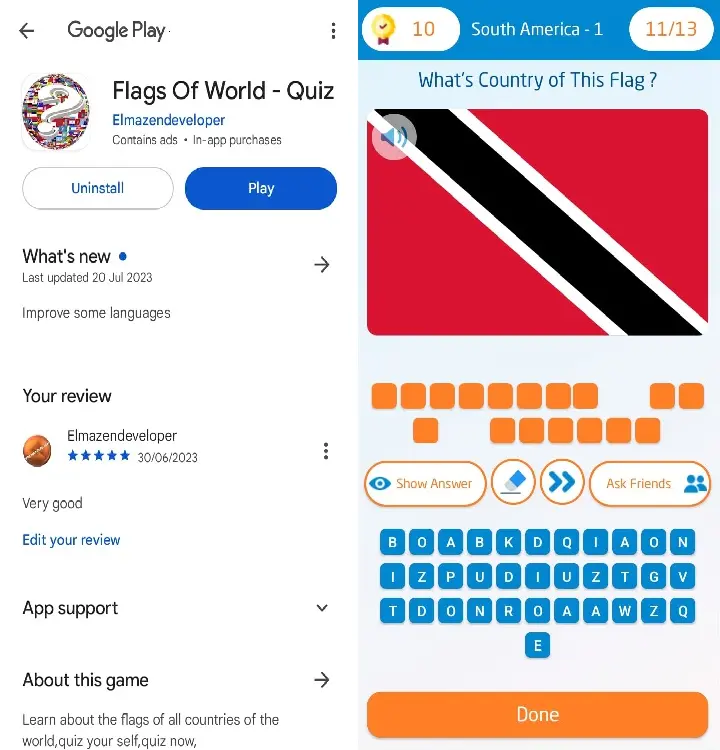
Download the application  Flags Of World - Quiz ,
Flags Of World - Quiz ,
And test your knowledge with Flags of World ,
1. Population of Trinidad and Tobago
As of November 2024, Trinidad and Tobago has an estimated population of 1.5 million people.
The majority of the population resides on the larger island, Trinidad, while Tobago is home to a smaller portion of the population.
The country's demographics are diverse, with a mix of ethnic groups, including people of African, Indian, European, Chinese, and Middle Eastern descent.
2. The Flag of Trinidad and Tobago: Meaning
The national flag of Trinidad and Tobago is a simple yet striking design.
It features three colors:
- Red symbolizes the vitality of the land and the energy and warmth of the people.
- White represents purity and the sea that unites and surrounds the two islands.
- Black signifies the strength, unity, and dedication of the people.
These colors together embody the nation's spirit and natural beauty.
3. Currency of Trinidad and Tobago
The official currency is the Trinidad and Tobago dollar (TTD).
It is symbolized as $ or sometimes TT$ to distinguish it from other dollar currencies.
The TTD is subdivided into 100 cents and is widely used for daily transactions across both islands.
Flag of Trinidad and Tobago

Download the application  Flags Of World - Quiz ,
Flags Of World - Quiz ,
And test your knowledge with Flags of World ,
4. Borders of Trinidad and Tobago
Trinidad and Tobago is an island nation, so it does not share any land borders with other countries.
However, it is located close to:
- Venezuela, just 11 kilometers (7 miles) to the southwest of Trinidad across the Gulf of Paria.
- Grenada, to the north of Tobago.
Being in close proximity to South America and other Caribbean islands has made Trinidad and Tobago a vibrant hub for trade and cultural exchange.
5. The Culture of Trinidad and Tobago
The culture of Trinidad and Tobago is a melting pot, influenced by African, Indian, European, Chinese, and Indigenous traditions.
Key aspects of its culture include:
- Carnival: One of the most famous celebrations, featuring vibrant costumes, music, and dancing.
- Music: The birthplace of calypso, soca, and steelpan music.
The steelpan, an instrument invented in Trinidad, is a symbol of national pride.
- Cuisine: A fusion of flavors, with popular dishes like doubles, roti, callaloo, and pelau.
- Religious Diversity: The country celebrates various religious festivals, including Diwali, Christmas, and Eid.
6. Best Places to Visit in Trinidad and Tobago
Here are some must-see attractions for anyone visiting the islands:
- Maracas Beach (Trinidad): A popular beach known for its golden sands and the famous local dish, "bake and shark."
- Pitch Lake (Trinidad): The world’s largest natural asphalt lake, a geological wonder.
- Asa Wright Nature Centre (Trinidad): A haven for birdwatchers and nature lovers.
- Store Bay (Tobago): A beautiful beach with turquoise waters, perfect for relaxation.
- Buccoo Reef and Nylon Pool (Tobago): A stunning coral reef and a natural shallow pool in the ocean, ideal for snorkeling.
- Pigeon Point Heritage Park (Tobago): Known for its iconic thatched jetty and pristine beaches.
Conclusion
Trinidad and Tobago is a vibrant and culturally rich nation, offering a mix of history, nature, and festivities.
From its diverse population to its stunning natural attractions, it’s a destination that captivates both locals and visitors alike.
Whether you’re planning a trip or just exploring from afar, this twin-island republic has something for everyone.
Flag of Trinidad and Tobago

Download the application  Flags Of World - Quiz ,
Flags Of World - Quiz ,
And test your knowledge with Flags of World ,
- Details
- Written by: Elmazen
- Category: Flags of Countries of the World
- Hits: 658
Flag of Suriname
Flag of Suriname, Currency, Population, Tourist Places, Culture, Borders
Discover Suriname: A Vibrant Blend of Culture and Nature
Suriname, a hidden gem in South America, is a small yet diverse country with a fascinating history and unique cultural tapestry.
Here's an overview of some key aspects of Suriname, from its demographics to its culture and natural wonders.
------------------
Flag of Suriname
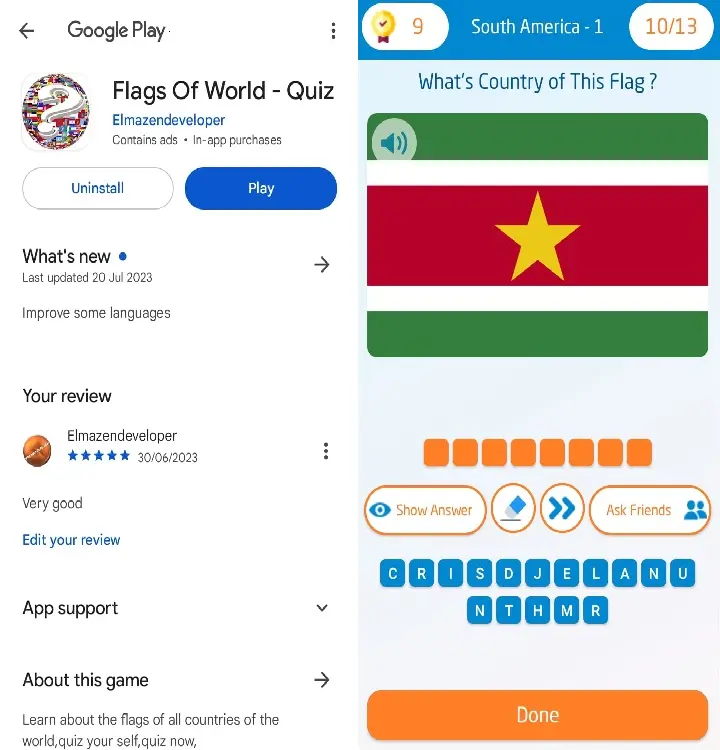
Download the application  Flags Of World - Quiz ,
Flags Of World - Quiz ,
And test your knowledge with Flags of World ,
1. Population of Suriname
Suriname has a population of approximately 636,500 people as of November 2024, making it one of the least populous countries in South America.
The majority of the population lives in the capital city, Paramaribo, and along the coastal areas.
Despite its small population, Suriname is ethnically diverse, with communities of Afro-Surinamese, East Indian, Javanese, Chinese, Indigenous peoples, and European descent.
------------------
2. Suriname's Flag and Its Meaning
Suriname’s flag, adopted on November 25, 1975, represents the country’s independence and unity.
The flag consists of:
Green stripes at the top and bottom, symbolizing the country's fertility and natural wealth.
White stripes between the green and red, representing peace and justice.
A red central stripe for progress, love, and sacrifice.
A golden star in the middle, symbolizing unity among the diverse ethnic groups of Suriname.
------------------
3. Currency of Suriname
The official currency of Suriname is the Surinamese Dollar (SRD).
Introduced in 2004 to replace the Surinamese Guilder, the SRD is used in daily transactions and is crucial for the country's economy, which relies on exports such as gold, oil, and agricultural products.
------------------
Flag of Suriname

Download the application  Flags Of World - Quiz ,
Flags Of World - Quiz ,
And test your knowledge with Flags of World ,
4. Suriname's Borders
Suriname is located on the northern coast of South America and shares borders with:
Guyana to the west,
French Guiana to the east,
Brazil to the south.
To the north, Suriname has a coastline along the Atlantic Ocean.
This geographical location makes it a blend of coastal plains and lush rainforest.
------------------
5. Culture of Suriname
Suriname is known for its vibrant and harmonious multicultural society.
The culture is a mix of influences from:
Indian and Javanese customs, stemming from indentured laborers.
European heritage, reflecting its Dutch past.
Religious and cultural diversity is evident in the peaceful coexistence of Hindu temples, mosques, Christian churches, and synagogues.
Popular festivals include Diwali, Eid al-Fitr, and Pagara Estafette (New Year's Eve celebrations).
Music, dance, and cuisine, such as roti, pom, and bami, showcase this cultural fusion.
------------------
6. Best Places to Visit in Suriname
Suriname boasts breathtaking natural and historical attractions.
Here are some of the top places to visit:
Paramaribo: The capital city is a UNESCO World Heritage Site, known for its architecture and vibrant markets.
Brownsberg Nature Park: A stunning rainforest reserve ideal for hiking and wildlife spotting.
Galibi Nature Reserve: Famous for sea turtle nesting during certain seasons.
Central Suriname Nature Reserve: A vast area of pristine rainforest, perfect for eco-tourism and home to unique wildlife.
Fort Zeelandia: A historical fort in Paramaribo, showcasing Suriname’s past.
Commewijne River: A scenic area for river cruises, where visitors can see traditional plantations and dolphins.
Voltzberg and Raleighvallen: Great for adventurers seeking waterfalls, exotic birds, and lush jungle scenery.
------------------
Suriname is a small country with a big personality.
Its combination of natural beauty, cultural diversity, and historical significance makes it a must-visit destination for travelers looking to explore off-the-beaten-path wonders.
Whether you're drawn by the allure of its rainforests or the warmth of its multicultural society, Suriname offers an unforgettable experience.
Flag of Suriname

Download the application  Flags Of World - Quiz ,
Flags Of World - Quiz ,
And test your knowledge with Flags of World ,
- Details
- Written by: Elmazen
- Category: Flags of Countries of the World
- Hits: 716
Flag of Peru
Flag of Peru, Currency, Population, Tourist Places, Culture, Borders
Discovering Peru: A Land of Rich Culture and Natural Wonders
Peru, a South American gem, is a country brimming with cultural heritage, stunning landscapes, and vibrant traditions.
Whether you’re a history enthusiast, a nature lover, or simply curious about this fascinating nation, here’s everything you need to know about Peru.
-----------------------
Flag of Peru
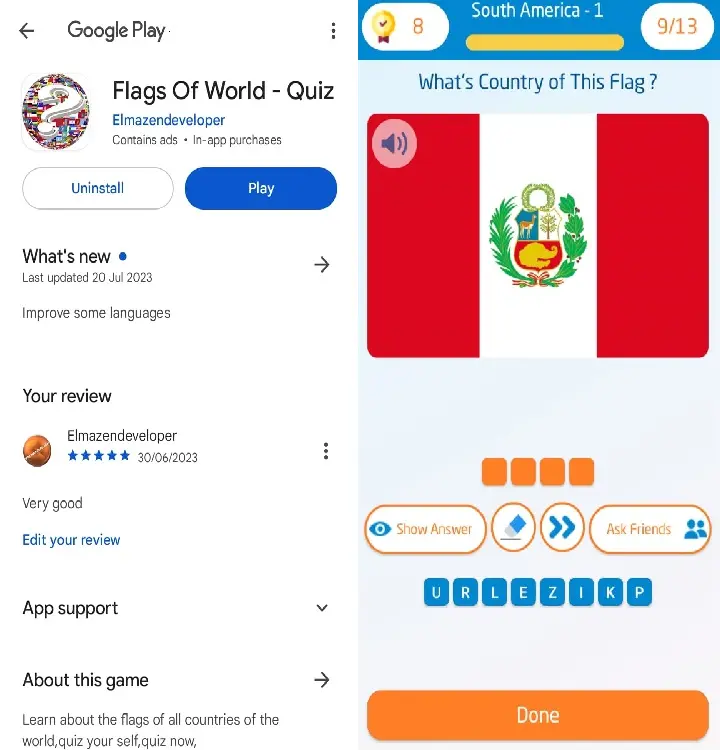
Download the application  Flags Of World - Quiz ,
Flags Of World - Quiz ,
And test your knowledge with Flags of World ,
1. Population of Peru
As of November 2024, Peru's population is approximately 34,356,700 million people.
The country is known for its cultural diversity, with a mix of Indigenous peoples, Europeans, Africans, and Asians contributing to its vibrant demographic makeup.
-----------------------
2. Meaning of Peru's Flag
The flag of Peru consists of three vertical stripes: red on both sides and white in the middle.
Red: Symbolizes the blood shed for Peru's independence and courage of its people.
White: Represents peace, purity, and justice.
The national emblem, when displayed on the state flag, includes a vicuña (a native animal), a cinchona tree (source of quinine), and a cornucopia (symbolizing prosperity).
-----------------------
3. Currency of Peru
Peru’s currency is the Peruvian Sol (PEN).
It is subdivided into 100 céntimos and is widely used throughout the country.
The sol is recognized for its stability and plays a vital role in Peru's robust economy.
-----------------------
Flag of Peru

Download the application  Flags Of World - Quiz ,
Flags Of World - Quiz ,
And test your knowledge with Flags of World ,
4. Peru’s Borders
Peru is located in western South America and shares borders with five countries:
East: Brazil,
West: The Pacific Ocean.
This strategic position gives Peru a mix of Andean highlands, Amazonian rainforests, and coastal deserts.
-----------------------
5. Culture of Peru
Peruvian culture is a unique blend of ancient traditions and modern influences.
Language: Spanish is the official language, but Quechua and Aymara are also widely spoken, reflecting the country’s Indigenous heritage.
Cuisine: Peru is famous for dishes like ceviche, lomo saltado, and ají de gallina.
The country has earned global recognition for its culinary excellence.
Festivals: Traditional festivals like Inti Raymi (Festival of the Sun) and Carnaval showcase colorful costumes, music, and dances.
Art and Crafts: From intricate textiles to hand-painted pottery, Peruvian art reflects centuries of Indigenous craftsmanship.
-----------------------
6. Best Places to Visit in Peru
Peru is home to some of the world’s most iconic destinations.
Here are a few must-visit places:
Machu Picchu: A UNESCO World Heritage Site and one of the New Seven Wonders of the World, this Inca citadel is a marvel of ancient engineering.
Cusco: The former capital of the Inca Empire, known for its rich history and architecture.
Lake Titicaca: The world’s highest navigable lake, offering stunning landscapes and unique floating islands.
The Amazon Rainforest: A paradise for biodiversity lovers, with eco-lodges and guided jungle tours.
Nazca Lines: Enigmatic ancient geoglyphs best viewed from the air.
Lima: Peru’s capital, blending historic landmarks with a thriving gastronomic scene.
Colca Canyon: One of the world’s deepest canyons, perfect for trekking and spotting Andean condors.
-----------------------
Conclusion
Peru is a country that captivates visitors with its incredible history, rich culture, and awe-inspiring landscapes.
Whether exploring ancient ruins, indulging in world-class cuisine, or soaking up its natural beauty, Peru offers an unforgettable experience for every traveler.
Flag of Peru
